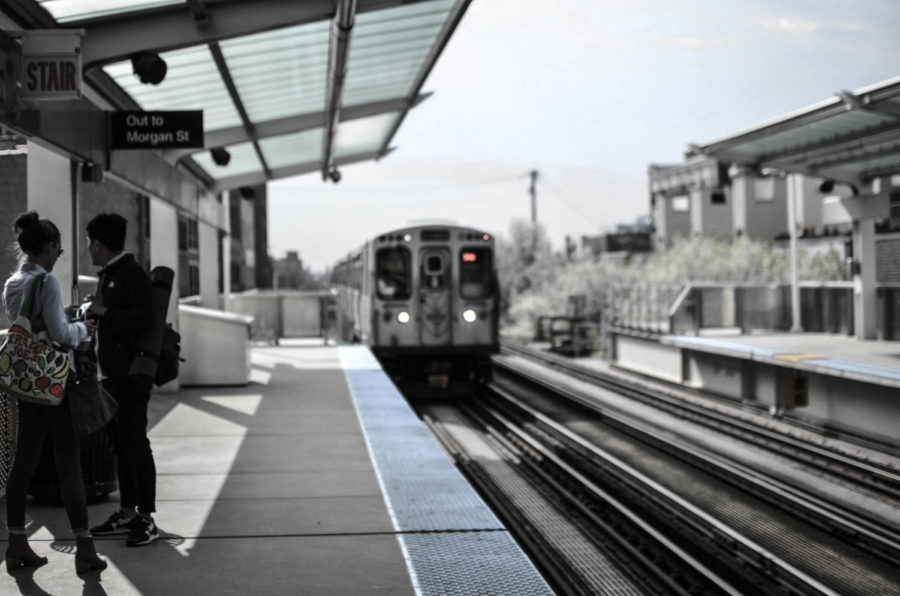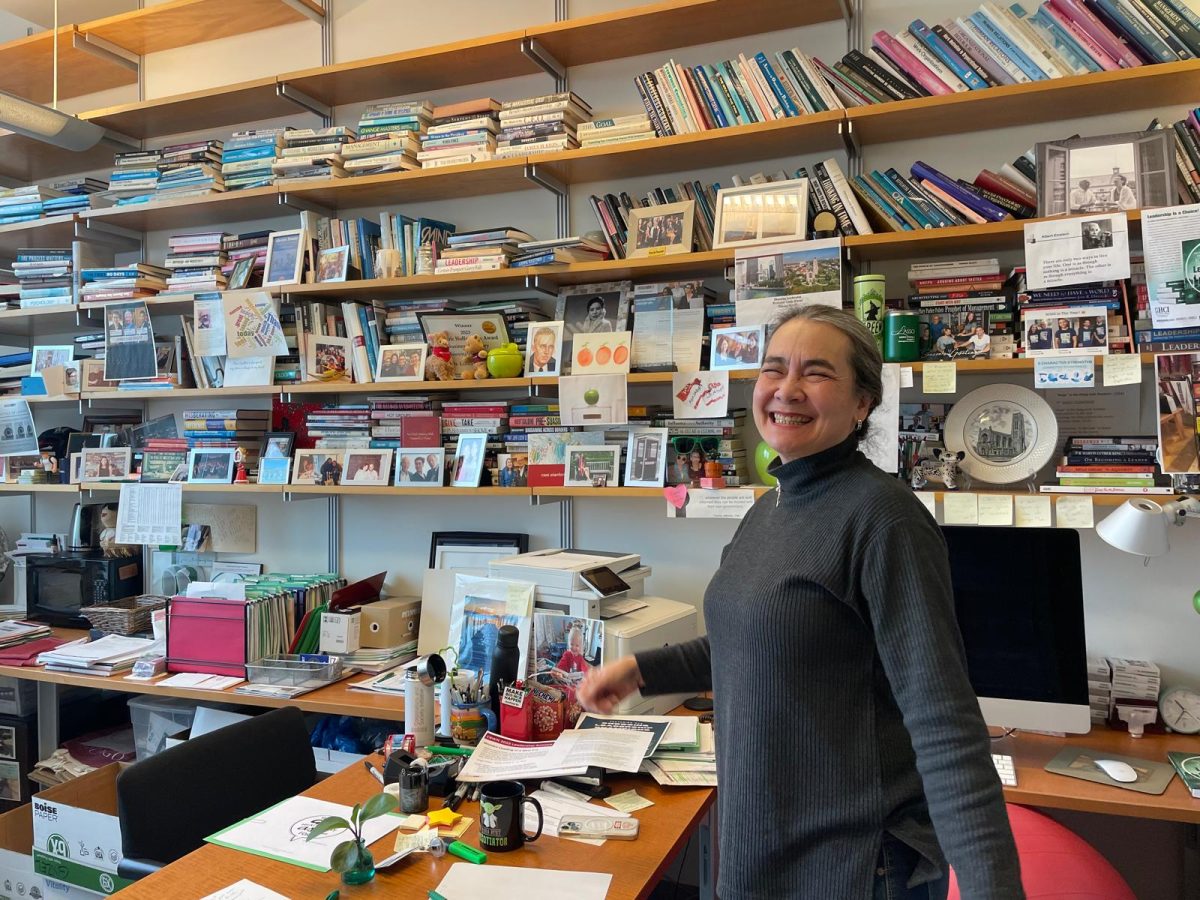The Green Line train rumbles along the tracks as it exits the station at East 63rd Street and South Cottage Grove Avenue just south of UChicago’s campus. Heading north toward downtown, the train takes you through the city’s South Side. Watch through the window as meticulously preserved classic Chicago homes blur into increasingly worn brick and stone buildings. The journey begins.
Speeding further north along the tracks, the train passes modern-looking townhomes that quickly bleed into the glimmering high-rise apartments and skyscrapers of the Loop. The doors slide open and snap shut as commuters come and go, filling the train car to capacity as it continues on its journey.
The story of Chicago’s explosive growth from the 19th century to the present day is defined by a willingness to adopt new means of transportation after the Industrial Revolution. Public transit began in Chicago in 1859 with horse-drawn streetcars that carried a whopping 18 passengers and moved at a blistering pace of three miles per hour. But an ambitious up-and-coming city would need something more reliable and innovative than horsepower to transport its people.
“Perhaps more than any U.S. city, Chicago is the product of rail transportation,” said Professor Joseph Schwieterman, director of the Chaddick Institute for Metropolitan Development at DePaul University. “It's impossible to conceive of Chicago as it exists today without taking into account the enormous legacy of the El. There are growth patterns between 1890 and 1920 that were driven heavily by access to convenient rapid transit. The alignment of our suburbs also reflects access to commuter rail lines.”
The year 1892 saw the first of Chicago’s rapid transit train lines begin service with the opening of the South Side Elevated, or the El, which connected the city’s downtown business district to 39th Street via 3.6 miles of elevated rail. Then, with the 1893 World’s Columbian Exposition on the horizon, the El was extended to Jackson Park over the course of a few weeks, bringing tourists and Chicagoans alike from downtown to the exposition. These trains established the viability of public transit in Chicago, crafting the blueprint and laying the foundation for our modern-day transit infrastructure. In fact, the Green Line of today runs over much of the original path first charted by the South Side Elevated over a century ago.
Chicago’s public transit network continued to grow throughout the 19th and 20th centuries with the addition of more rail lines and bus routes as well as the construction of the iconic downtown Loop. The Loop’s spoke-and-hub design carries passengers from all over Chicago and the suburbs to the central business district. Chicago’s public transit was consolidated under the Chicago Transit Authority (CTA) in 1947. Today the CTA operates eight rail lines and 140 bus routes, providing transit service to Chicago and the Chicagoland area.
Rolling on through the west side of the city, the train passes by old factories that have long since shut their doors. Soon, suburban homes drift into view as the train approaches its destination. The brakes catch on the tracks, squealing as the train draws into the station at Harlem and Lake in the suburb of Oak Park. An announcement comes on the intercom:
“This is the last stop.”
Suffering from declining usage, increasing operation costs, concerns over safety, and disputes over reliability, public transit systems in cities like Chicago are faced with immense fiscal and political challenges. “Public transit faces an uphill battle,” Schwieterman said. Especially as more employees work from home and pursue jobs in areas outside of the Loop, Chicago’s transit system has seen a loss in ridership, which translates to a loss in profits needed to operate the transit system as a whole. “Fewer people are traveling to offices in the urban center, which puts great stress on our transportation system,” Schiweterman said.
However, the City of Chicago’s prioritization of access to the Loop via public transit and its lack of investment in other areas have created long-standing problems in equitable transit access in the city. For those who don’t work in the Loop, there are few transit options available, making a car an expensive but necessary cost for those working in the suburbs or one of the city’s other business centers.
On the South Side and Far South Side especially, transit options are few and far between when compared with those on the North Side. Even before the pandemic, residents of the city’s South Side recognized the need for transit improvements to provide greater and more reliable access to jobs around the city, not just in the Loop.
The COVID-19 pandemic has further widened the disparity in transit access throughout Chicago. With many people working from home during the pandemic, the CTA saw declining ridership and staff shortages and subsequently reduced the number of scheduled trains and buses. This left many Chicagoans, particularly those who depend on public transit to reach jobs and basic necessities such as groceries and health care, with limited access to transit. “The riders that continued to use public transit, even throughout the pandemic, were not necessarily going to the Loop,” said Heidy Persaud of the urban planning nonprofit Center for Neighborhood Technology. “They were going to other areas in the city to access work or basic needs. And service to those areas are not as [frequent] or not as quick as they are to the Loop, or there's just less options overall.” Especially on the city’s South Side and Far South Side, access to nearby and reliable transit remains an issue for residents, a problem further exacerbated by reductions in scheduled CTA trips.
Broader concerns about safety and reliability have also plagued the city’s transit system over the course of the pandemic, resulting in increased concerns about crime as well as the phenomenon of “ghost buses,” which are buses that are scheduled to arrive at a stop but often never show for hours, if at all. These factors highlight the stark inequities in the city’s transit infrastructure and the fact that, in many instances over the last few years, the CTA has struggled to meet Chicagoans’ commuting needs.
Another factor contributing to the decline in transit access is the loss of multifamily housing near transit stations. The construction of single-family homes in areas closest to public transit has reduced the number of people able to live within walking distance of accessible transit. This is produced by increased gentrification and zoning practices, said Emily Talen, a professor of urbanism at the University of Chicago. “Not only is that a matter of people moving away, but in my neighborhood, Lincoln Park, there have been demolitions of multifamily housing near transit stations happening, and then they get replaced with luxury single-family homes,” Talen said.
This loss of multifamily housing has been a pervasive theme within Chicago’s urban landscape. Many neighborhoods on the city’s North Side have seen historic multifamily homes either demolished or converted to make way for single-family homes, reducing broader access to transit and forcing residents to find more affordable neighborhoods. On the South Side, multifamily homes have in many instances been foreclosed and demolished, leaving nothing but empty homes and vacant lots. What’s more is that significant portions of the land area around transit lines on the North Side, particularly the Brown and Blue Lines, are restricted to permit only the construction of single-family housing.
The train engine roars to life once again, the wheels beginning to turn as you head back towards the city. The sun hangs low on the horizon behind you, illuminating the path forward. The journey begins anew.
Across the city of Chicago and the nation, numerous projects that aim to increase access to public transit and augment transit equity in cities are underway. The Fair Transit South Cook pilot program, a joint project between Metra, Pace, and the Regional Transportation Authority (RTA), began this past winter and will extend into 2023. The project has reduced fares and increased service across several Metra train lines, aiming to boost ridership by making the Metra a more affordable transit option. Additionally, the city of Chicago has begun its Equitable Transit-Oriented Development (eTOD) Pilot Program, which states its mission to be expanding access to “dense, mixed-use, pedestrian-oriented development near transit hubs.”
The rise of bicycle-sharing services like Divvy can further augment transit accessibility in Chicago. “Not everybody has access to the most frequent public transit system right at their doorstep,” said Preeti Shankar, director of urban analytics at the Center for Neighborhood Technology. “So the bike shares can supplement some of that. You could ideally ride your Divvy bike to the train station, park it outside the train station, take a train, come back, finish your ride, and do the same and get back home.” The Divvy for Everyone initiative also serves to reduce barriers to accessing the bike share service, offering qualifying Chicago and Evanston residents $5 annual memberships. Divvy has rolled out its e-bikes over the past several years and plans to introduce e-scooters to the city streets after a successful pilot program this May, expanding the service and further broadening the transit capabilities of Chicago.
Furthermore, the recent federal infrastructure bill, combined with state funds set aside for development, should result in massive transit development in Chicago over the next several years. The most visible transit project on the docket for the CTA is the Red Line Extension Project, which would add 5.6 miles of track and four new stations to the Red Line, extending it from its current terminus at East 95th Street to East 130th Street, providing greater access and enhanced transit options for the Far South Side.
Still, concerns remain over whether investing in Chicago infrastructure will be enough to upgrade transit service and provide greater equity in the city. “I think we're about to enter a great, grand experiment to see if investing in our infrastructure will be enough to keep public transit, to push public transit ridership back to pre-pandemic levels,” Schwieterman said. “The infrastructure bill that passed will allow for lots of improvements, lots of modernization. But it’s an open question whether ridership is going to bounce back to pre-pandemic levels, and in fact, I would say it’s probably unlikely that we’ll see public transit, particularly rail systems, return to pre-pandemic levels anytime soon.”
For a city like Chicago, where the issue of improving transit has been largely neglected because of the political costs of such an endeavor, it remains unclear whether the necessary improvements will happen. All told, it is uncertain whether the massive collection of public and private solutions to furthering transit equity in Chicago will be enough to address steep inequities.
But, taken together, the influx of funding and ingenuity going into rebuilding and reimagining Chicago’s transit infrastructure over the next few decades inspires cautious optimism. Long-standing structural issues and inequities are at last beginning to be taken seriously and factored into the decision-making process concerning transit. What’s more, improving transit has become politically advantageous and savvy for otherwise opposed politicians.
While Chicago’s transit system will likely not see dramatic changes overnight, the wheels on the tracks toward progress have begun to turn, with many of the components necessary to create lasting structural and equitable improvements to the city’s transit infrastructure now underway. There’s no guarantee that any or all of these solutions will create the change many Chicagoans are hoping to see, but they are progressing in the right direction. So let’s take a ride and see where the next few years of transit improvement take us.










Roger Deschner / Nov 7, 2022 at 11:46 pm
Transit expansion has not been smooth or well planned. A prime example has been the failure of the proposed extension of the CTA Red Line to connect for direct transfers to the Metra Electric Line. The end of the Red Line at 130th St. will be a long walk or a bus ride to Metra Electric trains. This must be fixed; there must be a direct transfer point.
This would be especially important if the Grey Line proposal happened. That would make the city portions of the Metra Electric Line to function as the CTA Grey Line. Suburban portions would remain as Metra lines. An transfer point between the Grey Line and the Red Line somewhere around 130th Street would help ridership on both.